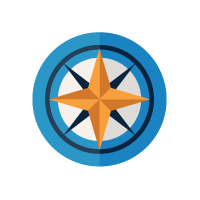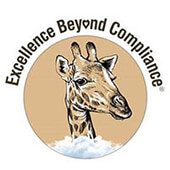 Academy Contributors Academy Contributors
Chart Your Journey
By Gary Priest, Curator of Animal Care Training, San Diego Zoo Global Academy
In January's column, I shared with you that it takes courage to launch into the unknown. That first column focused on encouraging you to prepare your staff for a new adventure with online training. Last month, in preparation for our voyage, we reviewed the importance of a compass for direction. Now we will consider the chart.
Launching your own Academy training program is not unlike taking a sailing voyage. On this voyage, The Academy is the ship's name. Planning and preparation are vital, and there are a few essential navigation tools that you'll need before you leave the dock.
It is always wise to begin with a destination in mind. The destination may be different for each institution, and it depends on multiple variables. Sailors plot their daily progress as they sail toward their destination, using a compass and a chart. The compass data is plotted on the chart, and the chart becomes a picture of the voyage. The chart reveals the distance traveled, the course direction, and speed. Importantly, the chart is based on the experience of others who have traveled before you, and it is also useful for revealing navigational dangers to avoid.
San Diego Zoo Global began our journey aboard The Academy with our animal care staff on August 22, 2013. Our chart was in the form of a memo from our president/CEO, chief life sciences officer, and chief human resources officer, and it was sent to all animal care staff. The memo charted our new direction and the course we would follow as we set sail. A particular final destination was not established, as ours was to be a voyage of exploration—and we are still on this voyage.
A few years later, in 2015, we updated our charts with a new document called The Academy Reference Guide. This new chart presented more detailed information to our staff about new courses, how to earn professional certificates, creating Do-It-Yourself training courses, and senior management's expectations for staff training accomplishments on this voyage.
The Academy Reference Guide has become so valuable to us and others that we have decided to update it annually, and make it available to help you on your own institution's journey. The 2017 version is now ready.
Academy Director Jon Prange and I will be at the AZA Mid-Year Meeting in Albuquerque, New Mexico between March 29 and March 31. We plan to bring a limited number of printed 2017 Academy Reference Guides, and we'd be delighted to hand you your own chart and discuss your voyage. Please stop by our booth to pick one up.
For any questions, contact Gary Priest, curator of animal care training, San Diego Zoo Global Academy, at gpriest@sandiegozoo.org.
Getting Better All the Time:
Making Inspection Reports Work for Animals
 By James F. Gesualdi By James F. Gesualdi
When you have that window of opportunity called a crisis, move as quickly as you can, get as much done as you can. There's a momentum for change that's very compelling.
—Anne M. Mulcahy
The moment of the inspection report is here. It is also the hour, day, year, and simply the time of the inspection report. All aboard. That means everyone in the zoological world from newest hire to longest serving board leader.
Inspections and Inspection Reports
The U.S. Department of Agriculture (USDA) Animal and Plant Health Inspection Service (APHIS) Animal Care unit uses regular, ongoing, unannounced inspections to administer and enforce the Animal Welfare Act (AWA). The frequency of these standard facility inspections is typically annual, unless it is a repeat inspection to follow up on the annual inspection. Other focused, specialized inspections (for example, potentially triggered by a complaint, new animal arrivals, a noteworthy animal passing, a high-profile incident, or media attention) vary by facility, in accordance with a number of factors, including facility compliance history. A "clean" inspection yields a statement on the inspection report that "No noncompliant items identified during this inspection."
When an inspector identifies an incidence where the AWA regulations are apparently not being met (for example, animal and veterinary care, facility conditions, or recordkeeping), that will be written up as a noncompliant item (NCI). The most serious noncompliant items are those with continuing adverse impacts on animal welfare, labeled DIRECT. When the same or a similar noncompliance is found during more than one inspection, it can be marked as REPEAT. It is important to note that a noncompliance may be corrected in one location, but if the same general noncompliance is not corrected on the opposite side of the facility or in an adjacent mammal exhibit, this can be recorded as a repeat noncompliance. When a noncompliance is relatively minor, and the inspector believes the facility is likely to promptly address it, the inspector may inform the facility that it is being considered a "teachable moment." Teachable moments do not appear in inspection reports, but are treated as part of one's compliance record—which could become a significant concern in the event some subsequent findings spark agency review of the facility.
Public Disclosure of Inspection Reports
Inspection reports are available to the public pursuant to the Freedom of Information Act (FOIA). FOIA and other federal laws, like the Privacy Act, may preclude release of certain limited information, but the general presumption is toward disclosure of the sum and substance of inspection reports. Under FOIA, inspection reports may be obtained pursuant to formal written and electronic requests. Significantly, inspection reports subject to an appeal are not posted online until the appeals process is concluded and a final inspection report is issued. Until recently, the agency has provided the most recent three years of inspection reports for every regulated entity via a searchable database (also including some other information), available 24/7/365 on the agency website.
The World Takes Notice of Inspection Reports
On February 3, 2017, the USDA took the database containing inspection reports offline (see public.govdelivery.com/accounts/USDAAPHIS/subscriber/new ) and posted an alert of the removal on the web page where the database had been available. The response to this action has been overwhelmingly critical, and the situation has been covered repeatedly in mainstream and social media. Regulated community accreditation organizations, such as the Association of Zoos and Aquariums (AZA), have weighed in, calling for the restoration of the database, stating that its availability helps demonstrate good compliance records (and animal welfare) essential to maintaining the public trust.
Litigation has ensued, and the individuals and organizations involved recited a litany of ways in which they use inspection reports. Such uses include monitoring AWA compliance and animal care and welfare; tracking animal acquisitions/transfers and reviewing potential placement locations for rescued animals; framing complaints to USDA and related litigation; and scholarly and other research on all of the above. Inspection reports are also used in administering state and local laws that regulate and prohibit the sales of domestic dogs from commercial breeders with problematic compliance histories.
The agency has been reposting portions of the re-reviewed inspection reports, and has invited FOIA requests (which can often take extensive time periods to process) for records that are no longer available online. There is no announced timeframe for the completion of the re-postings and restoration of the database.
Improving the Situation By Getting Better and Focusing Efforts on Animals
Applying the Excellence Beyond Compliance® approach, the zoological community (and others) can take this situation and "make it better" in a way that truly serves the interests of animals.
- Everyone in your organization should have some awareness of the AWA, inspections, and inspection reports. Raising awareness internally opens the door for everyone to contribute to AWA compliance and animal welfare. Examples: picking up litter, detecting unusual animal behavior, or reporting facilities issues.
- Key leaders and officials should be briefed and updated on inspections, inspection reports, and corrective measures/improvements. Board members, directors, management, animal and veterinary care, communications and marketing, facilities, and security staff should have current knowledge of compliance history.
- Take time to find and review your inspection reports online, and all reports for at least the past 10 years. If there is a noncompliance (including teachable moments) in your history, ask whether any such conditions exist or are likely to reoccur, and what should be done to improve things. Then, get into action making improvements.
- Review other facilities' inspection reports (zoological organizations, facilities in your state, or the site of a recent high-profile situation). There may be issues elsewhere that prompt a fresh look at your own operation.
- Conduct an internal debriefing immediately after every inspection/inspection report. Take stock of what went well and things to improve. After a clean report, challenge yourself to find new ways to advance your work on behalf of animals.
- Address and document corrective measures/improvements. Act promptly yet thoughtfully to make things better, and document that work to demonstrate good efforts and to start off the next inspection.
- Self-report your compliance and improvements to the agency. This ensures more up-to-date and accurate information—which can be a tremendous asset when you least expect it—and drives further improvements in animal care and welfare. This report can be a brief summary of enhancements, with more detailed information and backup available upon inspection, or for further use by the media, the public, or others. (Eventually, good, forward-looking actions like this might lead to self-posting of inspection reports and enhancements, to transparently demonstrate your commitment to getting better.)
The above measures would: (1) make this information more readily accessible and transparent; (2) stress the importance of striving to maintain consistent compliance; (3) foster continuous improvement, especially in animal care and welfare; and (4) further demonstrate the zoological community's commitment to AWA compliance and animal welfare, in a manner that justifies and validates the public trust.
These ideas seek to make the most good come from the current USDA database situation, as well as spur each zoological organization to be its very best every day in making animals' lives better.
Close scrutiny will show that most "crisis situations" are opportunities to either advance, or stay where you are.
—Maxwell Maltz
Please email me at jfg@excellencebeyondcompliance.com to share the good you are doing (as only you can), or with any comments or questions on this column or suggestions for future ones. For upcoming workshops and sessions, contact: info@excellencebeyondcompliance.com.
© 2017 James F. Gesualdi, P.C. The opinions expressed herein are solely those of the author. This is not, nor should it be construed as, legal advice. |